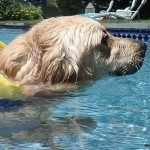Are you a pet lover who’s curious about dew claws and whether or not golden retrievers have them? If so, you’re not alone. Dew claws are a hot topic among dog owners, breeders, and enthusiasts alike. These tiny appendages located on the inner side of your dog’s front paws (and sometimes on their hind legs) have been the subject of fascination and controversy for years.
But here’s the scoop: unlike some other breeds, golden retrievers do indeed have dew claws. And these little digits serve some pretty important functions. For starters, they help dogs grip when running, jumping, and playing – acting like a permanent thumb on their paws. They also contribute to the stability of the leg and provide additional traction.
Despite these benefits, some pet owners choose to remove their dog’s dew claws for various reasons. But before you make that decision for your furry friend, it’s crucial to understand the implications of this procedure on their overall health and wellbeing.
That’s where we come in. In this informative blog post, we’ll be exploring everything you need to know about golden retrievers and dew claws – from what they are and how they work to the potential consequences of removing them. So buckle up and get ready to dive into the fascinating world of dew claws in golden retrievers with us.
Do Golden Retrievers Have Dew Claws?
Contents
- 1 Do Golden Retrievers Have Dew Claws?
- 2 Why Do Dogs Have Dew Claws?
- 3 The Role of Dew Claws in a Dog’s Anatomy
- 4 Potential Risks of Having Dew Claws on Golden Retrievers
- 5 How to Care for Your Golden Retriever’s Dew Claws
- 6 Tips for Protecting Your Golden Retriever’s Dew Claws During Activities
- 7 Conclusion
Like most other dog breeds, golden retrievers do indeed have dew claws. These handy little digits are essentially extra toes located higher up on a dog’s paw that don’t touch the ground.
Typically, dew claws are found on a dog’s front paws, but some breeds may also have them on their hind paws. Golden retrievers usually have dew claws on their front legs, which can come in various shapes and sizes, including double dew claws.
While dew claws may not serve a specific purpose for most dogs, they can be useful for working dogs who need added grip and traction. However, they can also get snagged or caught on things, causing discomfort or injury to the dog. For this reason, some owners opt to remove their dog’s dew claws when they are puppies.
But let’s be clear: dew claw removal is a hotly debated issue in the dog world. Some argue that it’s unnecessary and cruel, while others believe it’s a necessary precaution to avoid potential injuries. Ultimately, the decision to remove your golden retriever’s dew claws is up to you. However, it’s important to discuss the matter with your veterinarian first and ensure that the procedure is done safely and humanely if you do choose to go ahead with it.
Regardless of whether or not you decide to remove your golden retriever’s dew claws, it’s crucial to keep them well-groomed and trimmed to avoid any potential injuries. During activities such as running or playing fetch, your furry friend may be more prone to injuring their dew claws, so keep an eye out for any signs of discomfort or pain.
Why Do Dogs Have Dew Claws?
These are called dew claws and they can be found on the front legs, usually higher up than the other toes. While not all dogs have them, some breeds, like golden retrievers, do. As an expert on the topic of “Why Do Dogs Have Dew Claws?”, let me walk you through the fascinating reasons behind their existence.
One theory is that dew claws act as an extra digit to help dogs climb and grip while walking on rough terrain. This would be especially useful for hunting or herding dogs who need to navigate challenging landscapes. Another potential advantage of dew claws is that they can help dogs maintain balance and stability while running and turning quickly. This is particularly important for athletic breeds like greyhounds or border collies, who need to move quickly and nimbly to perform their tasks effectively.
Interestingly, some experts believe that dew claws may also have evolutionary significance. It’s thought that these extra digits were once fully formed toes that were used by canids to climb trees. Over time, however, the need for climbing ability decreased as dogs evolved and adapted to different environments, and these digits became less important. Eventually, they evolved into the dew claws we see today.
While dew claws may serve a functional purpose, it’s important to note that they can sometimes cause problems for dogs if not properly maintained. If left untrimmed, dew claws can grow too long and curl around, digging into the skin and causing pain or infection. In some cases, they may even become injured if snagged on something.
Therefore, it’s crucial for dog owners to monitor their pet’s dew claws and ensure they’re well-groomed and healthy. If you’re uncertain about whether your dog’s dew claws should be removed or not, consult with a veterinarian who can offer expert advice based on your dog’s individual needs.
The Role of Dew Claws in a Dog’s Anatomy
These small, extra toes located on the inner side of a dog’s paw may seem insignificant, but they actually serve an essential role in a dog’s anatomy. As an expert in this field, I am excited to share with you the fascinating world of dew claws.
Firstly, dew claws act as thumbs for dogs – an invaluable tool for hunting and working dogs who need to grip and hold onto their prey or tools. But that’s not all; dew claws also help dogs maintain balance and stability while running, jumping, or making quick turns. They serve as a pivot point for the dog’s leg, providing support and stability during these movements.
In addition to providing grip and balance, dew claws also offer an extra layer of protection for a dog’s paw. They act as shock absorbers, reducing the impact when a dog lands from a jump or runs on hard surfaces. Dew claws also provide additional traction when walking on slippery surfaces, decreasing the risk of slips and falls.
It’s important to note that some dog breeds have their dew claws removed at a young age, such as golden retrievers. However, this procedure can have negative consequences for the dog’s wellbeing. Dew claws are not just vestigial structures; they play an important role in a dog’s life. Removing them can result in decreased grip strength and stability, which can ultimately harm the dog’s overall health.
Potential Risks of Having Dew Claws on Golden Retrievers
One of the most significant concerns is the possibility of dew claws getting caught on something. This can happen during playtime, walks or even while running, resulting in severe pain and discomfort for your Golden Retriever. A catch can lead to skin tearing or even worse, a broken bone. This could cause significant pain and require costly medical attention.
Furthermore, if your Golden Retriever loves to swim, dew claws can make swimming difficult. As they fill with water, the extra toes can hinder their swimming ability, causing them to tire out more easily and even become distressed in the water. As a responsible pet owner, it’s essential to monitor your pet while they’re swimming to keep them safe.
Another concern is that dew claws can easily become infected if not adequately cleaned and maintained. Dirt and debris can accumulate around the extra toe, leading to bacterial growth and infection. This could cause pain and discomfort for your furry friend and will require medical attention from a qualified veterinarian.
How to Care for Your Golden Retriever’s Dew Claws
Golden Retrievers are some of the sweetest and most affectionate dogs out there. But as a Golden Retriever owner, you need to pay attention to their dew claws. Dew claws are extra toes that don’t touch the ground when your dog walks. They are located on the inner side of their paw, and if not properly cared for, they can cause discomfort or even pain to your furry friend. Here are five tips for caring for your Golden Retriever’s dew claws:
Check Them Regularly
Dew claws can easily get caught on things, leading to injuries or infections. That’s why it’s crucial to check them regularly. Take a close look at the dew claw area and watch out for any signs of redness, swelling, or discharge. If you notice anything unusual, contact your veterinarian right away.
Keep Them Trimmed
Dew claws can quickly grow too long and curl around, which can be painful for your dog. To prevent this from happening, make sure to regularly trim your dog’s dew claws. Use proper nail clippers and be careful not to cut too close to the quick – the pink part inside the nail that contains blood vessels and nerves.
Clean Them Regularly
To prevent infections, it’s important to clean your dog’s dew claws regularly. Use a cotton ball or soft cloth soaked in warm water or an antiseptic solution to clean the area around the dew claw. Ensure that you dry it thoroughly afterward to avoid moisture buildup.
Protect Them During Activities
Golden Retrievers love playing and running around, but these activities can put their dew claws at risk of injury. You can protect them by using protective booties or avoiding rough terrain whenever possible.
Contact Your Veterinarian If Needed
If you notice any unusual swelling, discharge, or if your dog is in pain, contact your veterinarian immediately. They can properly diagnose and treat any issues with your dog’s dew claws.
Tips for Protecting Your Golden Retriever’s Dew Claws During Activities
However, as much as we love our furry friends, it’s crucial to take care of their dew claws during activities to prevent injury and ensure their wellbeing. In this blog post, we’ll discuss five steps owners can take to protect their Golden Retriever’s dew claws during activities and keep them healthy and happy.
Step 1: Keep them trimmed
Long dew claws are more susceptible to injuries during activities such as hiking or playing fetch. To prevent this from happening, make sure to trim your Golden Retriever’s dew claws regularly. This will reduce the risk of the claw catching on something and getting torn or ripped. Owners can trim their dog’s dew claws at home with a pair of sharp nail clippers or take them to a professional groomer for regular trimming.
Step 2: Use protective booties
Protective booties or socks can provide extra cushioning and support for your Golden Retriever’s paws during high-risk activities such as hiking or jogging on pavement. These booties can also help prevent debris from getting caught in the dew claw, reducing the risk of injury.
Step 3: Avoid rough terrain
Rough terrain can be challenging for your dog’s paws, including their dew claws. If possible, avoid taking your furry friend on rough terrain to prevent injury or discomfort. Instead, opt for walking on grass or soft surfaces.
Step 4: Monitor for signs of injury
After any activity that may have put your Golden Retriever’s dew claws at risk, it’s essential to monitor their paws for signs of injury. Signs of a dew claw injury include limping, swelling, bleeding, and excessive licking of the paw. If any of these symptoms are present, seek veterinary care immediately to prevent further complications.
Step 5: Consider removal
If your Golden Retriever is prone to injuring their dew claw, you may want to consider having them removed by a licensed veterinarian. This procedure is typically done when the dog is a puppy and can prevent future injuries and discomfort.
Conclusion
In conclusion, it is important to note that golden retrievers do indeed have dew claws. These small appendages may seem insignificant, but they play a vital role in providing extra grip and stability during activities like running and jumping. While some owners opt to remove their dog’s dew claws, it is a contentious issue that should be discussed with a veterinarian first.
It is crucial for pet owners to monitor their furry friend’s dew claws regularly. Failure to do so can result in injuries or infections that can pose serious risks to your pup’s health. By keeping your Golden Retriever’s dew claws clean and trimmed, you can help prevent these potential hazards from occurring.
To ensure your furry friend stays safe during activities like hiking or running on rough terrain, consider using protective booties. If you notice any signs of discomfort or injury in your pup’s paws or dew claws, seek veterinary care immediately.
In the end, caring for your Golden Retriever’s dew claws is an essential part of maintaining their overall health and wellbeing.









